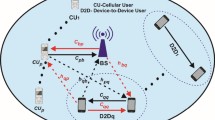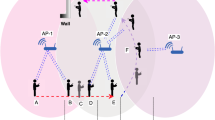Abstract
Multihop cellular network (MCN) has been proposed to incorporate the flexibility of ad hoc networks into traditional single-hop cellular networks (SCNs). The performance analysis of MCN through analytical models is not trivial because the classic Erlang B formula no longer applies to MCN where multihop transmission is allowed. In this paper, we first propose a clustered MCN (cMCN) architecture with the use of dedicated information ports (DIPs), which are deployed wireless ports functioning as central controllers for multihop users. The proposed cMCN can be considered as a complement of the existing cellular network. Then, we study the feasibility of modeling time division multiple access (TDMA)-based cMCN with fixed channel assignment (FCA) scheme for uplink transmission. An exact multi-dimensional Markov chain model to analyze the performance of cMCN with FCA is developed. Furthermore, an approximated model which results in reduced complexity is also presented. The analytical results from both models are matched with the simulation results closely. The results show that cMCN with the proposed FCA scheme can reduce the call blocking probability significantly as compared to SCNs with either the conventional FCA or a dynamic channel assignment (DCA) scheme.










Similar content being viewed by others
References
Li, X. J., Seet, B.-C., & Chong, P. H. J. (2008). Multihop cellular networks: Technology and economics. Computer Networks, 52(9), 1825–1837. doi:10.1016/j.comnet.2008.01.019.
Hsu, Y.-C., & Lin, Y.-D. (2002). Multihop cellular: A novel architecture for wireless data communications. Journal of Communications and Networks, 4(1), 30–39.
Wu, H., Qiao, C., De, S., & Tonguz, O. (2001). Integrated cellular and ad hoc relaying systems: iCAR. IEEE Journal on Selected Areas in Communications, 19(10), 2105–2115. doi:10.1109/49.957326.
Luo, H., Meng, X., Ramjee, R., Sinha, P., & Li, L. E. (2007). The design and evaluation of unified cellular and ad-hoc networks. IEEE Transactions on Mobile Computing, 6(9), 1060–1074. doi:10.1109/TMC.2007.1035.
Zhou, J. J., & Yang, Y. R. (2002). PARCelS: Pervasive ad-hoc relaying for cellular systems. Proceedings of the Med-Hoc-Net’02, Sardegna, Italy (pp. 1–6).
Long, L., & Hossain, E. (2007). Multihop cellular networks: Potential gains, research challenges, and a resource allocation framework. IEEE Communications Magazine, 45(9), 66–73. doi:10.1109/MCOM.2007.4342859.
He, J., Yang, K., Guild, K., & Chen, H.-H. (2007). Application of IEEE 802.16 mesh networks as the backhaul of multihop cellular networks. IEEE Communications Magazine, 45(9), 82–90. doi:10.1109/MCOM.2007.4342861.
Aggelou, G. N., & Tafazolli, R. (2001). On the relaying capability of next generation GSM cellular networks. IEEE Personal Communications, 8(1), 40–47. doi:10.1109/98.904898.
Wu, H., & Qiao, C. (2003). Modeling iCAR via multi-dimensional Markov chains. Mobile Networks and Applications, 8(3), 295–306. doi:10.1023/A:1023349916384.
Katzela, I., & Naghshineh, M. (1996). Channel assignment schemes for cellular mobile telecommunication systems: A comprehensive survey. IEEE Personal Communications, 3(3), 10–31. doi:10.1109/98.511762.
Chong, P. H. J., & Leung, C. (2001). A network-based dynamic channel assignment scheme for TDMA cellular systems. International Journal of Wireless Information Networks, 8(3), 155–165. doi:10.1023/A:1012378931278.
Grace, D., Tozer, T. C., & Burr, A. G. (2000). Reducing call dropping in distributed dynamic channel assignment algorithms by incorporating power control in wireless ad hoc networks. IEEE Journal on Selected Areas in Communications, 18(11), 2417–2428. doi:10.1109/49.895046.
Rappaport, S. S., & Hu, L.-R. (1994). Microcellular communication systems with hierarchical macrocell overlays: Traffic performance models and analysis. Proceedings of the IEEE, 82(9), 1383–1397. doi:10.1109/5.317084.
Yu, J. Y., & Chong, P. H. J. (2005). A survey of clustering schemes for mobile ad hoc networks. IEEE Communications Survey and Tutorials, 7, 32–48. doi:10.1109/COMST.2005.1423333.
Hong, X., Xu, K., & Gerla, M. (2002). Scalable routing protocols for mobile ad hoc networks. IEEE Network, 16(4), 11–21. doi:10.1109/MNET.2002.1020231.
Ramanathan, R., & Steenstrup, M. (1998). Hierarchically-organized, multihop mobile wireless networks for quality-of-service support. Mobile Networks and Applications, 3(1), 101–119. doi:10.1023/A:1019148009641.
Kudoh, E., & Adachi, F. (2005). Power and frequency efficient wireless multi-hop virtual cellular concept. IEICE Transactions on Communication E, 88B(4), 2485–2489.
Kleinrock, L. (1975). Queueing system (1st ed.). New York: Wiley.
Author information
Authors and Affiliations
Corresponding author
Appendices
Appendix 1
The concept of cMCN can be extended for use with other reuse factors. For any reuse factor, N r , the original macrocell area (in SCN) is divided into N r microcells; one BS microcell and N r − 1 virtual microcells. Figure 11(a and b) illustrate how to construct cMCN with reuse factors, N r = 3 and N r = 4, respectively. As compared to original single-hop macrocell (in SCN), the virtual macrocell is shifted by some degree. However, the area of the virtual macrocell is same as the area of the original single-hop macrocell. For N r = 3, 4, and 7, a multihop call needs to go through 1 virtual microcell to reach the BS. However, for N r ≥ 9, a multihop call may need to go through two or more virtual microcells to reach the BS.
Appendix 2
An example of the approximated model for the two-cell cMCN with N 0 = 4 and N 1 = 4 is shown in Fig. 12.
Appendix 3
For a given state \( (n_{0} (s),n_{1} (s),n_{2} (s),n_{3} (s),n_{4} (s),n_{5} (s),n_{6} (s)) \) in the approximated model, Fig. 13 shows the algorithm on how to obtain the calls combination table, where \( n_{i}^{j} [C] \) indicates the value of \( n_{i}^{j} \) for C th combination.
Rights and permissions
About this article
Cite this article
Li, X.J., Chong, P.H.J. Performance analysis of multihop cellular network with fixed channel assignment. Wireless Netw 16, 511–526 (2010). https://doi.org/10.1007/s11276-008-0150-1
Published:
Issue Date:
DOI: https://doi.org/10.1007/s11276-008-0150-1







